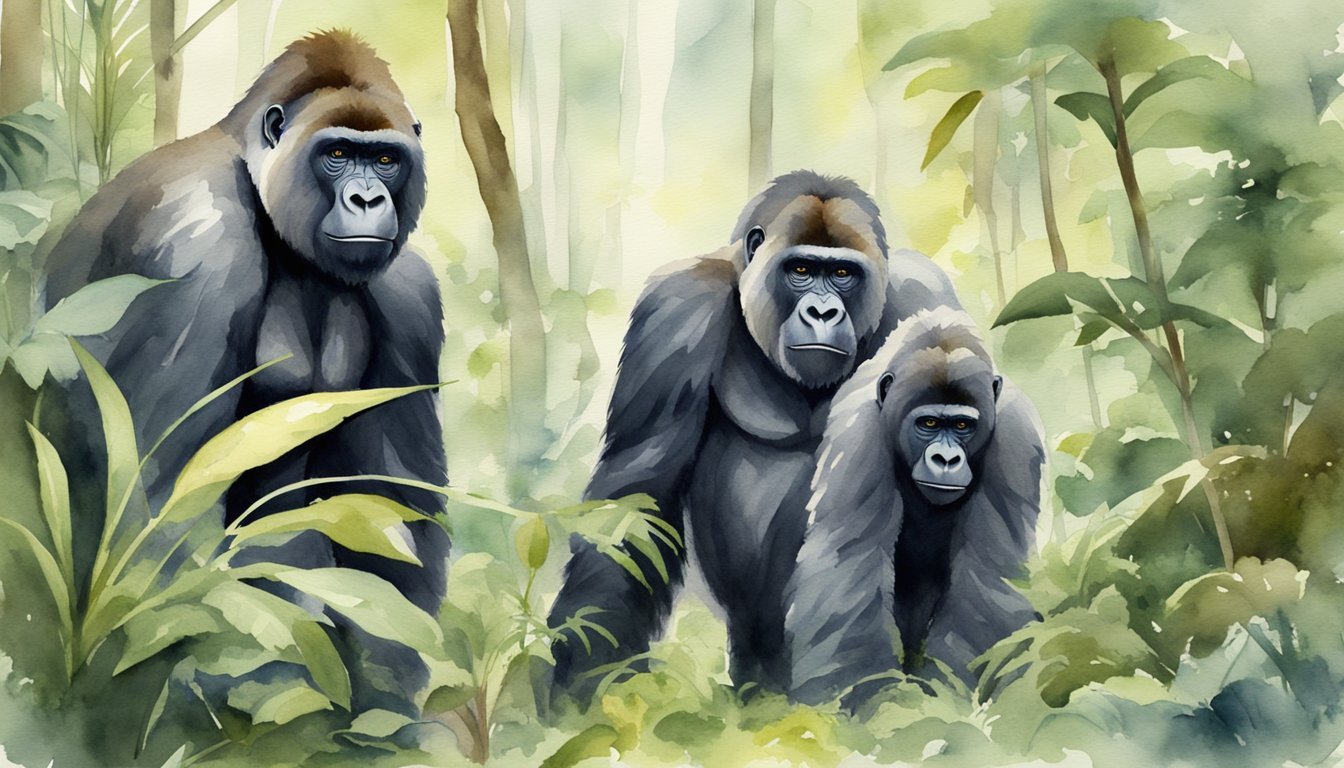Gorilla Characteristics
Physical Attributes
Gorillas are the largest living primates, with males generally weighing between 136 to 227 kg (300 to 500 lb) and females weighing 68-113 kg (150-250 lb). Males have an arm span of 2.3 to 2.6 m (7 ft 7 in to 8 ft 6 in) and females are slightly shorter at 1.25 to 1.5 m (4 ft 1 in to 4 ft 11 in). Their skin color is black and they have small eyes, a prominent brow ridge, and large nostrils. Adult males, called “silverbacks,” have a distinctive patch of silver hair on their back, which develops upon reaching maturity.
In addition to these physical traits, gorillas have powerful arms, which are longer than their legs. This makes them adapted for their ground-dwelling and tree-climbing lifestyle in equatorial African forests, such as the Congo.
Diet and Nutrition
Gorillas are primarily vegetarian, consuming up to 30kg of vegetation per day. Their diet consists of:
- Fruits
- Leaves
- Stems
- Roots
- Bark
However, some subspecies are known to eat insects and snails. Since they have a relatively slow digestive system due to their large size, gorillas need a large home range to access sufficient amounts of vegetation.
Social and Behavioral Traits
Gorillas have a complex social structure consisting of family groups composed of one dominant silverback, multiple females, and their offspring. These family groups may range from a few individuals to over 30 members. Adult males sometimes form all-male groups.
Gorillas share 98.3% of their DNA with humans, leading to many human-like behaviors and emotions such as play and sadness. They also use sounds and body language for communication.
The gestation period for gorilla infants is about nine months. Female gorillas invest a lot of time and care in raising their young. Infants learn to crawl at around two months old and begin to play around three months old.
Gorillas are also known to construct nests for sleeping using surrounding vegetation. Finally, it’s worth noting that gorillas have been observed using tools in the wild, exhibiting intelligence and problem-solving abilities.
Conservation and Threats

Endangered Status and Protection
Gorillas are one of the world’s most endangered species, with certain subspecies like the Cross River gorilla and the mountain gorilla facing critically endangered status. Their vulnerability is due to various factors like poaching, disease, and habitat loss.
Gorillas are divided into two species, eastern and western, which are further subdivided into four subspecies: eastern lowland gorilla, mountain gorilla, western lowland gorilla, and Cross River gorilla. Mountain gorillas, of which there are only about 1,000 individuals left, reside in dense forests at high altitudes in Uganda, Rwanda, and the Democratic Republic of Congo. In contrast, western lowland gorillas inhabit the lowland swamps and forests of Central Africa and are considered as the most numerous subspecies.
Conservation efforts have focused on protecting these great apes and their habitats, with organizations like WWF dedicating resources for this cause. A notable success has been seen in the mountain gorilla population, which experienced moderate growth in recent years.
Human Interaction and Coexistence
Unfortunately, gorillas face numerous threats from human activities. One primary concern is the commercial trade in bushmeat, a practice in some regions of West and Central Africa where gorilla meat is considered a prestigious dish among the wealthy elite.
Habitat loss is another pressing issue, as human encroachment, agriculture, logging, and other activities lead to shrinking natural habitats for gorillas. The dwindling habitat not only affects the gorillas but also thousands of other species that share the same ecosystem.
Disease poses an additional threat, as gorillas share 98.3% of their genetic code with humans, making them susceptible to many human diseases. Organizations like IFAW promote conserving these animals by supporting government policies, collaborating with local communities, and increasing awareness.
Gorillas are known to be highly intelligent, with some individuals like Koko taught to communicate using sign language. They play essential roles in maintaining the biodiversity of their habitat by spreading seeds and promoting the growth of essential plants like bamboo forests. Consequently, the conservation of gorillas and their coexistence with humans is vital for maintaining the balance and health of the ecosystems they inhabit.

